Chrysler Neon
| Dodge/Chrysler/Plymouth Neon | |
|---|---|
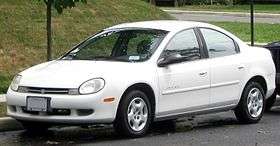 | |
| Overview | |
| Manufacturer |
Chrysler Corporation (1995–1998) DaimlerChrysler (1998-2005) Fiat Chrysler Automobiles (2017-present) |
| Also called |
Chrysler Neon Dodge Neon Plymouth Neon (1995-2001) Dodge SX 2.0 (Canada) Dodge SRT-4 (2003–2005) |
| Production |
1993–2005[1] 2016–present |
| Assembly |
|
| Body and chassis | |
| Class | Small car |
| Layout | Transverse front-engine, front-wheel drive |
| Platform | Chrysler PL platform |
| Related | |
| Chronology | |
| Predecessor |
|
| Successor | Dodge Caliber |
The Plymouth/Dodge/Chrysler Neon is a front-engine, front-wheel drive sport compact car introduced in January 1994 for model year 1995 by Chrysler's Dodge and Plymouth divisions in two- and four-door bodystyles over two generations.
Marketed in Europe, Mexico, Canada, Japan, Egypt, Australia and South America as a Chrysler, the Neon was offered in multiple versions and configurations over its production life, which ended with model year 2005.
The Neon nameplate was subsequently resurrected in 2016 for the Dodge Neon, a rebadged variant of Fiat Tipo sedan for the Mexican market.[2]
1991 concept car
The Neon nameplate first appeared as a concept car in 1991 under the Dodge brand. Although radically styled and clearly not production-ready, the Neon concept somewhat resembled the production vehicle and featured sliding suicide doors.[3][4]
The Neon concept was designed by Chrysler designers who had joined the company from Chrysler's buyout of American Motors in 1987.
First Generation (1995–1999)
| First generation | |
|---|---|
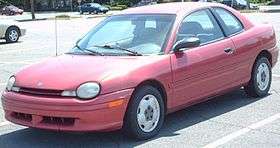 1996-1999 Dodge Neon coupe | |
| Overview | |
| Also called |
|
| Production | November 10, 1993 – August 1999 |
| Designer | Thomas Gale (1991)[5] |
| Body and chassis | |
| Class |
Compact sedan Coupe |
| Body style | |
| Powertrain | |
| Engine | |
| Transmission |
|
| Dimensions | |
| Wheelbase | 104.0 in (2,640 mm) |
| Length | 171.8 in (4,360 mm) |
| Width | 67.5 in (1,710 mm) |
| Height | 54.9 in (1,390 mm) |
The first generation Neon was introduced in January 1994 and manufactured until August 1999. It was available as a four-door notchback sedan and a two-door notchback coupe. Available engines were SOHC and DOHC versions of Chrysler's 2.0 L 4-cylinder engine producing 132 hp (98 kW) at 6,000 rpm and 129 lb⋅ft (175 N⋅m) at 5,000 rpm or 150 hp (110 kW) at 6,500 rpm and 133 lb⋅ft (180 N⋅m) at 5,600 rpm, respectively; transaxle options were a 3-speed Torqueflite automatic or a five-speed manual.
The car was badged and sold as both a Dodge and a Plymouth in the United States and Canada; in Mexico was sold as Dodge and Chrysler, and in Europe, Australia and other export markets it was sold as the Chrysler Neon. At the Neon's release, then president of Chrysler Corporation Bob Lutz said, "There's an old saying in Detroit: 'Good, fast, or cheap. Pick any two.' We refuse to accept that."[6] The Japanese press touted the Neon as the "Japanese car killer", due to a spiralling Yen and the lower production cost of the Neon.[7] The Neon received praise for its appearance, price, and power when compared to competing cars such as the Honda Civic DX at 102 hp (76 kW), the Civic EX at 127 hp (95 kW), the Nissan Sentra at 115 hp (86 kW), the Ford Escort ZX2 at 130 hp (97 kW), the Toyota Corolla at 115 hp (86 kW), the Saturn S-Series at 100 hp (75 kW) for SOHC variants and 124 hp (92 kW) for DOHC variants, and the Chevrolet Cavalier Base and LS models at 120 hp (89 kW), among others. Car and Driver tested the DOHC 5-speed equipped Neon R/T and reported that it could run 0-60 in 7.6 seconds and 15.9 seconds in the quarter mile. First-generation Neons were competitive in SCCA Solo autocross and showroom-stock road racing.[8]
Equipment
Neons had unconventional option availability, including the lack of power windows in the rear doors. Certain color base-model Neons, including red and black, had bumper covers molded in color rather than painted. These covers, while textured and not as glossy as paint, absorbed scuffs and scrapes with less visible damage. The mid-level Highline models in 95 & 96 used wheel covers with a bubble design. Initially, Neons were available in many bold colors including Nitro yellow-green, Lapis Blue, Aqua, and Magenta, however paint color choices became more subdued by the 1998-1999 model years, as the majority of buyers opted for more traditional colors.
The Australian market Chrysler Neon came in two models, the SE and the better-equipped LX. Later, the LX model was replaced by the LE with the updated model in 1999.
It was the first Chrysler small car sold in Japan, starting in 1996-1998, but only the sedan was offered. It was sold at Mitsubishi dealerships as well as Yanase dealerships, and very similar to those sold in the Australian market. it was equipped with amber turn signal indicators next to the tail lights to comply with Japanese regulations, and a side indicator behind the front wheel installed in the fender. Sales were curtailed due to the exterior dimensions placing the car in the "normal size" classification according to Japanese Government dimension regulations which incurred a higher tax obligation. Sales were also affected by the Japanese economic recession due to the collapse of the Japanese asset price bubble, otherwise known as the "bubble economy".
In the United States, the lineup started out as Base, Highline, and Sport, with different styles and options in each line, but the lineup titles changed frequently (other trim lines included Expresso, SE, ES, SXT, ACR, and R/T).
In Europe, the car was available with a 1.8 L engine. Europe received one limited edition model, the CS, which came only in Platinum paint. It was fitted with the 131 bhp (98 kW) SOHC engine, American R/T specification suspension (slightly lower, 3.5 cm (1.4 in) rear, 2.7 cm (1.1 in) front), rear spoiler, unique alloy wheels, standard leather interior, dual stainless steel exhaust, 6CD changer and a shorter 5-speed manual gearbox.
Trim levels

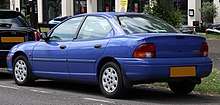
Plymouth Neon: 1994–1999
- base - 1994-1995 - Standard features included thirteen-inch (13") steel wheels with wheel covers, AM/FM stereo with 4 speakers, dual front SRS airbags, 2.0L Inline Four-Cylinder (I4) engine, five-speed manual transmission.
- Highline - 1994–1999- Added to Base air conditioning, side molding, daytime lights, remote trunk release, painted bumper.
- Sport - 1994–1996- Added to Highline color-keyed wheel covers, AM/FM stereo with cassette player with equalizer and CD changer controls and 6 speakers.
- Expresso - 1995–1999- Added to Highline power front windows an AM/FM stereo with cassette player.
- EX - 1997–1999
- ACR - 1994–1999- Stood for American Club Racer, added alloy wheels to Base.
- Style - 1997–1999
Dodge Neon: 1994–1999
- base - 1994-1995- Standard features included thirteen-inch (13") steel wheels with wheel covers, AM/FM stereo with 4 speakers, dual front SRS airbags, 2.0L Inline Four-Cylinder (I4) engine, five-speed manual transmission.
- Highline - 1994–1999- Added to Base air conditioning.
- Sport - 1994–1999- Added to Highline color-keyed wheel covers, AM/FM stereo with cassette player with equalizer and CD changer controls and 6 speakers.
- EX- 1997–1999
- ACR - 1994–1999- Stood for American Club Racer, added alloy wheels to Base.
- R/T - 1997–1999- Added to Highline white hood and trunk "Rally" stripes, white-painted alloy wheels, AM/FM stereo with cassette player with equalizer and CD changer controls and 6 speakers, and rear spoiler.
Chrysler Neon (Canada): 1999–2002
- LE - 2000–2002 (entry level trim)
- LX - 2000-2002
- R/T – 2001-2002 (manual transmission only)
Chrysler Neon (Europe): 1994–1999
- LE - 1994–1999
- LX - 1994–1999
- SLX - June 1997 – 1999
- GLX - October 1997 – 1999
- CS - February 1998 – 1999
Special models
ACR
The ACR Neon, available with the DOHC engine, featured four-wheel disc brakes, Arvin non-adjustable struts for 1995–1996 models and Koni adjustable dampers for 1997–1999 models, thicker anti-sway bars, stiffer suspension bushings, fast-ratio steering, heavy-duty wheel hubs, and a five-speed manual transmission with a shorter .81 fifth gear and final drive ratio of 3.94 for quicker acceleration. 1995 through 1997 models featured adjustable camber. The computer-controlled speed limiter was removed from 1995 ACR models (limited to 130 mph (210 km/h) on later models), and ABS was also, to save weight. The ACR offers no badging to distinguish it from other Neon models; the only visible differences are a bumper with fog light holes, but no fog lights and a lack of side moldings. For 1995, the ACR was only offered to SCCA members, but in subsequent years it was available to the general public. The name "ACR" was initially the internal ordering code for the "Competition Package", as it was termed in dealer materials; however, as knowledge of the model spread, the ACR name stuck. The backronym "American Club Racer" was coined due to its popularity with club and grassroots racers. To save weight, both the standard A/M-F/M radio with cassette player and air conditioning could be deleted, both for credit.
R/T
The R/T model (Road/Track) debuted in the 1998 model year. Offered only with a 5-speed DOHC configuration, the R/T featured many of the ACR's mechanical upgrades including the numerically higher ratio 3.94 5-speed manual transmission, with the .81 5th gear and 130 mph speed limit. The R/T, however, was intended for the street, with more comfort and convenience features standard or available, and specialized parts like the adjustable dampers removed, although the dampers as well as the front coil springs found on R/T models were slightly stiffer, offering an advantage over standard model Neons. R/Ts featured optional stripes over the top of the car, silver "R/T" badging on the front door panels and the right side of the trunk deck lid, and a functional wing. The "Stripe Delete" option was available from the factory, but with no credit to the Neon's price. All striped R/Ts (black, red, blue) had silver colored stripes, with the exception of the White R/Ts, which came with dark blue colored stripes. The R/T also came in 4-door form with limited numbers made.
Second Generation (2000–2005)
| Second generation | |
|---|---|
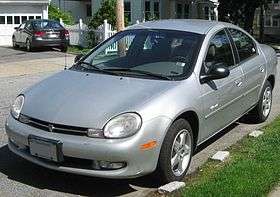 | |
| Overview | |
| Also called |
|
| Production | 1999–2005 |
| Designer | Robert McMahan; Robert Boniface (1996) |
| Body and chassis | |
| Class | Compact sedan |
| Body style | 4-door sedan |
| Related | Dodge SRT-4 |
| Powertrain | |
| Engine | |
| Transmission |
|
| Dimensions | |
| Wheelbase | 105.0 in (2,670 mm) |
| Length | 174.4 in (4,430 mm) |
| Width | 67.4 in (1,710 mm) |
| Height | 56.0 in (1,420 mm) |
Sales of the second generation model started with model year 2000 and production ended with the 2005 model year. The second generation Neon was only available as a four-door sedan. In some global sales regions, including the U.S., the sole engine was the 2.0 L SOHC engine, the power output remaining at 132 hp (98 kW). An optional Magnum engine configuration (with an active intake manifold, and other engine revisions to increase power) that produced 150 hp (110 kW) was available. Both engines had a redline of 6762 rpm.
.jpg)
The second generation was more refined than the first generation car. It was advertised that the second generation Neon had over 1,000 refinements from the original generation. The first generation's frameless windows were replaced with a full-framed door. Other NVH refinements were implemented. The new interior and greater size increased weight. The DOHC engine (Chrysler code name ECC) was no longer available.
In 2000, the R/T trim returned after a one-year hiatus. The R/T consisted of a new 150 hp (110 kW) SOHC Magnum 2.0 L Engine, 16 in (41 cm) wheels, spoiler, dual chrome exhaust tips, quicker steering box and stiffer springs. The 2001 and 2002 R/Ts had a flat, 'hammerhead' spoiler. From 2000-2003, the R/T was sold as a Chrysler in the United Kingdom. The Neon was offered with a sport package for the 2001 model year only commemorating Dodge's return to the NASCAR scene, called the Motorsports Edition. It was available on SE, ES, and R/T and on SE/ES models, consisted of an R/T wing, R/T 16 in (41 cm) wheels, R/T springs, Goodyear NASCAR raised yellow-lettering tires, 'Dodge Motorsports' side decals, white instrument cluster and R/T steering box. SE and ES cars were an R/T visually except for the lack of dual exhaust, R/T lower mouldings, fog lamps and R/T exclusive front bumper. The SE and ES only came equipped with the base model's 132 hp (98 kW) engine and was available with an automatic transmission (unlike the manual-only R/T model), the R/T retained the 150hp Magnum engine. In 2001, there was also a Sport Appearance Package available on SE and ES, which added the R/T wing and 16” wheels as well as other option availability. 2001 was the last year for the Plymouth Neon, and the Plymouth brand as well. The last Plymouth Neon, which was also the last Plymouth ever produced (a silver four-door sedan), rolled off the assembly line on June 28, 2001.
The former Dodge and Plymouth Neon were briefly sold under the Chrysler name in Canada from 1999–2002, until being renamed as Dodge SX 2.0 for 2003. As before, in Europe, Australia, Mexico, Asia and South America, it continued to be sold as a Chrysler, as Dodge and Plymouth passenger cars were not marketed outside the U.S. and Canada at the time. Besides the 2.0 L engine, it used the same Tritec 1.6 L unit found in the MINI prior to 2007. The 1.6 L unit is a variation of the 2.0 L SOHC engine designed by Chrysler and built by Tritec.[9]
Originally, the second generation Neon featured a five-speed manual transmission using the former ACR gear ratios to improve acceleration. However, this hurt gas mileage and made the car noisier on the highway, and eventually the original gear ratios were restored. A four-speed automatic (41TE) was offered in the Neon for the 2002 model year, and the 03-05 received an updated 40TE four-speed auto, replacing the earlier 3-speed 31TH.
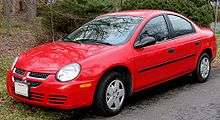
The Neon's name was changed to SX 2.0 in Canada in 2002. In Australia and Canada, the Chrysler Neon was discontinued in 2002. In 2002, the front clip was changed to match the R/T and ACR front clip with the exception of missing a lower lip.
The Neon was facelifted once again for 2003 with large "crosseyed" headlights and crosshair grille to make it look more like a Dodge Caravan and Dodge Stratus.
The ACR model was discontinued for 2003; the R/T model for 2004. The Chrysler Neon continued to be sold in Europe until 2004.
In Brazil, the Neon was marketed as a luxury mid-size sedan; for Mexico it was a competitor to the Ford Escort, and sold as a Chrysler with either the 1.6 or 2.0 L engine and European-style taillights (with separate amber indicator lights), except for the R/T model, which was a Dodge, with U.S.-style taillights.
For the Dutch market, the Neon proved more successful than for the rest of the Continent. Trim levels were 2.0 LX and 2.0 SE. However, some grey import versions came in from Mexico.
This generation continued to be offered in Japan from 1999-2001. The Japanese version was installed with leather interior, and was marketed as a small luxury car to Japanese consumers. In 2002, the Neon was replaced by the Chrysler PT Cruiser in Japan.
Trim levels
Dodge Neon: 2000–2005
- Highline - 2000–2001- Included 2.0L Inline Four-Cylinder (I4) engine, 5-speed manual transmission, A/M-F/M stereo with cassette player and 4 speakers, fourteen-inch (14") steel wheels with wheel covers, manual windows, manual door locks, manual air conditioning, and antilock braking system (ABS).
- ES - 2000–2002- Added fifteen-inch (15") alloy wheels, power door locks, and power front windows to Highline.
- SE - 2001–2005- Basically same features as Highline.
- R/T - 2001–2004- Added color-keyed exterior features and rear spoiler to ES.
- Motorsports Edition - 2001
- ACR - 2001-2002- Stood for American Club Racer.
- base - 2002
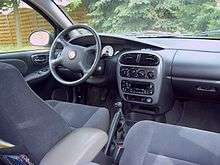
- S - 2002
- SXT - 2002–2005- Added fifteen-inch (15") alloy wheels, A/M-F/M stereo with single-disc CD player and 6 speakers, rear spoiler, power front windows, keyless entry, and power door locks to SE.
- SRT-4 - 2003–2005- A turbocharged and intercooled 2.4 liter inline-4 gasoline engine (A853 engine) was used, 2.25" exhaust with 2 resonators, no muffler, and dual 3.75" stainless steel tips, suspension upgrades (stiffer springs & struts, ACR came with adjustable Tokico Illumina struts), larger brakes, 17x6 alloy wheels (16x7 for ACR), and high-profile rear wing spoiler.
Plymouth Neon: 2000–2001
- Highline - 2000–2001- Included 2.0L Inline Four-Cylinder (I4) engine, 5-speed manual transmission, A/M-F/M stereo with cassette player and 4 speakers, fourteen-inch (14") steel wheels with wheel covers, manual windows, manual door locks, manual air conditioning, and antilock braking system (ABS).
- LX - 2000–2001
Chrysler Neon: 2000–2004 (Europe)
- R/T - 2000–2003
- LX - 2000–2004
- SE - 2000–2003
Chrysler Neon: 2000–2002 (Canada)
- LE - 2001 Limited Edition
- SE - 2000–2002
Final year
DaimlerChrysler discontinued the Neon, with the final cars assembled on September 23, 2005 at the Belvidere Assembly plant in Belvidere, Illinois.[10] The Neon was replaced in the spring of 2006 with the 2007 Dodge Caliber, which is based on the shared Chrysler/Mitsubishi Motors GS platform. Like the Neon, the Caliber had an SRT-4 variant, but like the standard Caliber, it used a completely different engine.[11] The Belvidere plant underwent retooling for the Caliber, Jeep Compass, and Patriot.
In markets like Australia the Neon range was reduced to either 2.0 LX or 2.0 SE models.
Safety
The first generation Neon earned a "Poor" rating in an offset frontal Crash test conducted by the Insurance Institute for Highway Safety . The second generation Neon earned a higher "Marginal" rating. The second generation were rated as "Poor" in the side impact crash test[12] (IIHS Safety ratings go from "Poor", to "Marginal", "Acceptable" and "Good"). By comparison, the Chevrolet Cavalier performed worse in the small car category in 2005, the Neon's final year.[13] Other cars made from 2000 to 2005 that were rated "Poor" when tested without optional side airbags included the Ford Focus, Toyota Corolla, Toyota Prius, Mitsubishi Lancer, and Chevrolet Cobalt. No small car made in this period, tested without side airbags, achieved better than a "Poor."[14]
In 2005, the Institute carried out side impact tests on 14 small car models, simulating an impact with an SUV. Among these, the Neon performed the worst. IIHS stated that the Neon had "...major problems beginning with its structure. This car is a disaster...The structure is poor...If this had been a real driver in a real crash, it's likely it wouldn’t have been survivable...if safety is a priority, the Neon is a small car to be avoided."[14]
Second generation headrests were rated as "Poor".[15]
Driver deaths fatality risks statistics — published by the IIHS — rated the Neon and 15 other vehicles among the "Highest rates of driver deaths.", The Neon had 161 driver deaths per million registered vehicle years, while the average for the Neon class (4-door small) was 103. Other small cars on the list included the Acura RSX (202), Kia Spectra hatchback (191), and the Mitsubishi Eclipse (169).[16]
Sales
| Calendar Year | United States | Canada | Total |
|---|---|---|---|
| 1994[17] | 178,960 | N/A | |
| 1995 | 240,189 | N/A | |
| 1996 | 245,303 | N/A | |
| 1997 | 208,652 | N/A | |
| 1998[18] | 196,497 | N/A | |
| 1999 | 183,797 | N/A | |
| 2000[19] | 163.332 | N/A | |
| 2001[19] | 137,353 | N/A | |
| 2002[20] | 126,118 | N/A | |
| 2003 | 120,101 | N/A | |
| 2004 | 113,476 | 14,876 | |
| 2005 | 113,332 | 15,064 | |
| 2006 | 17,239 | 1,847 | |
| Sales total 2,076,136 |
Third generation (2016–present)
| Third generation | |
|---|---|
|
2016 Fiat Tipo, the basis for the third generation Neon. | |
| Overview | |
| Also called |
Fiat Egea (Turkey) Fiat Tipo (Europe) Dodge Neon (Middle East/Mexico) |
| Production | 2016–present |
| Assembly | Bursa, Turkey (Tofaş) |
| Designer | Centro Stile Fiat |
| Body and chassis | |
| Class | Compact car (C) |
| Body style | 4-door sedan (2016-) |
| Layout | Front-engine, front-wheel-drive |
| Platform | FCA Small Wide |
| Related | Fiat 500L |
| Powertrain | |
| Engine |
1.4 L Fire I4 (petrol) 1.4 L T-Jet I4 (petrol) 1.4 L T-Jet I4 (petrol/LPG) 1.4 L T-Jet I4 (petrol/CNG) 1.6 L E.torQ I4 (flexfuel) 1.3 L Multijet I4 (diesel) 1.6 L Multijet I4 (diesel) |
| Transmission | |
| Dimensions | |
| Wheelbase | 2,636 mm (103.8 in) |
| Length | 4,532 mm (178.4 in) |
| Width | 1,792 mm (70.6 in) |
| Height | 1,497 mm (58.9 in) |
| Curb weight | 1150-1270 kg |
The third generation of the Dodge Neon is the sedan version of Fiat's Project Ægea, adapted for the Mexican market and marking a comeback of the Neon nameplate after an 11-year absence.[21] Released for the 2017 model year around the same time the Dodge Dart is expected to end production, Automobile Magazine (sister publication to Motor Trend) confirmed in May 2016 that it would be sold in the U.S. and Canadian markets by 2018 as a replacement for the Dart.[2] To keep consistent with FCA's plans to dedicate U.S. production to Jeep and Ram vehicles while technically importing Chrysler and Dodge passenger cars from Canada and Mexico, the Neon will be built and imported from Turkey.
As of September 2018, the third-generation Dodge Neon has not yet entered the US or Canadian markets.
References
- ↑ "Chrysler's Belvidere Assembly and Stamping Plant". Allpar. 1993-11-10. Retrieved 2015-05-15.
- 1 2 Is the Dodge Neon Coming Back to the U.S.? Automobile (May 2016)
- ↑ http://oldconceptcars.com/1930-2004/dodge-neon-concept-1991/
- ↑ http://blog.modernperformance.com/check-out-this-1991-brochure-from-chrysler-on-the-neon-concept
- ↑ Woodruff, David; Miller, Karen Lowry (1993-05-02). "Chrysler's Neon". Businessweek. Archived from the original on 2013-06-28. Retrieved 2015-05-15.
- ↑ Ingrassia, Paul; White, Joseph (1994). Comeback: the fall and rise of the American automobile industry. New York: Simon & Schuster. p. 449. ISBN 0671792148.
- ↑ "Will Neon Be the Little Car That Could in Japan?". Bloomberg Businessweek. 1996-06-09. Retrieved 2015-05-15.
- ↑ LeBlancurl, John (2005-12-02). "Farewell road test: 2005 Dodge SRT4 Editor's Review". Auto123.com. Archived from the original on 2008-02-10. Retrieved 2015-05-15.
- ↑ "The Chrysler/Mini (Rover) 1.4 and 1.6 Engines". Allpar. Retrieved 2015-05-15.
- ↑ "Dodge Neon History". dodge-neon.net.
- ↑ "Dodge Caliber: crossover-like compact cars, 2007-2012". Allpar. Retrieved 2015-05-15.
- ↑ "IIHS-HLDI: Dodge Neon". Iihs.org. Archived from the original on November 28, 2008. Retrieved 2009-08-01.
- ↑ "IIHS News: March 6, 2005" (PDF). Archived from the original (PDF) on November 27, 2008. Retrieved 2009-08-01.
- 1 2 "Insurance Institute for Highway Safety Report" (PDF). Iihs.org. 2005-03-06. Archived from the original (PDF) on 2011-07-01. Retrieved 2015-05-15.
- ↑ "Head restraints: Dodge". Iihs.org. Archived from the original on July 30, 2009. Retrieved 2009-08-01.
- ↑ "Driver´s deaths by make&model: Fatality risk in one vehicle versus another" (PDF). Status Report. IIHS. 42 (4). 2007-04-19. Archived from the original (PDF) on 2008-11-27. Retrieved 2015-05-15.
- ↑ All par (Chrysler, Plymouth, and Dodge Neon cars, 1995-2005)
- ↑ Car Sales Base (Dodge Neon)
- 1 2 Auto Intell (Chrysler Group: Historic Sales and Production Figures)
- ↑ Good Car Bad Car (Dodge Neon Sales Figures)
- ↑ "2016 Dodge Neon For Mexico Leaked". FCAuthority. 2016-02-18. Retrieved 2016-04-20.
External links
| Wikimedia Commons has media related to Dodge Neon. |
| Wikimedia Commons has media related to Plymouth Neon. |
- Chrysler.com - 2001 Plymouth Neon, courtesy of Internet Archive
- "Chrysler, Plymouth, and Dodge Neon cars, 1995-2005". Allpar.com. Retrieved 2015-05-15.
- Yetter, Gene. "Car of the Month: 446,000 Mile Dodge Neon R/T". Allpar. Retrieved 2015-05-15.
« previous — Dodge road car timeline, international market, 1980s–present | ||||||||||||||||||||||||||||||||||||||
|---|---|---|---|---|---|---|---|---|---|---|---|---|---|---|---|---|---|---|---|---|---|---|---|---|---|---|---|---|---|---|---|---|---|---|---|---|---|---|
| Type | 1980s | 1990s | 2000s | 2010s | ||||||||||||||||||||||||||||||||||
| 0 | 1 | 2 | 3 | 4 | 5 | 6 | 7 | 8 | 9 | 0 | 1 | 2 | 3 | 4 | 5 | 6 | 7 | 8 | 9 | 0 | 1 | 2 | 3 | 4 | 5 | 6 | 7 | 8 | 9 | 0 | 1 | 2 | 3 | 4 | 5 | 6 | 7 | |
| Subcompact | Omni | Atos | Atos | |||||||||||||||||||||||||||||||||||
| 024 | Charger | Brisa | Brisa | i10 | Vision | |||||||||||||||||||||||||||||||||
| Challenger | Verna | Attitude | Attitude | Attitude | ||||||||||||||||||||||||||||||||||
| Colt | Colt | Colt | Colt | Forza | ||||||||||||||||||||||||||||||||||
| Arrow | ||||||||||||||||||||||||||||||||||||||
| Celeste | ||||||||||||||||||||||||||||||||||||||
| Compact | Colt | |||||||||||||||||||||||||||||||||||||
| Polara | ||||||||||||||||||||||||||||||||||||||
| 1500 | ||||||||||||||||||||||||||||||||||||||
| Dart | ||||||||||||||||||||||||||||||||||||||
| Magnum | Dart K | Shadow | Neon | Neon | Caliber | Dart | Neon | |||||||||||||||||||||||||||||||
| Aspen | Aries | 2000GTX | SX 2.0 | Trazo | ||||||||||||||||||||||||||||||||||
| SuperBee | Magnum | Magnum | SRT-4 | |||||||||||||||||||||||||||||||||||
| Mid-size | Alpine | Lancer | ||||||||||||||||||||||||||||||||||||
| 400 | Dart E | |||||||||||||||||||||||||||||||||||||
| Dart | 600 | Spirit | GTS | |||||||||||||||||||||||||||||||||||
| Mirada | Dynasty | Stratus | Stratus | Avenger | ||||||||||||||||||||||||||||||||||
| Diplomat | Avenger | |||||||||||||||||||||||||||||||||||||
| Full-size | St. Regis | Monaco | Intrepid | Intrepid | Magnum | |||||||||||||||||||||||||||||||||
| Charger | Charger | |||||||||||||||||||||||||||||||||||||
| Sports | Stealth | |||||||||||||||||||||||||||||||||||||
| Daytona | SRT-10 | Challenger | ||||||||||||||||||||||||||||||||||||
| Conquest | Viper | Viper | Viper | Viper | Viper | |||||||||||||||||||||||||||||||||
| ||||||||||||||||||||||||||||||||||||||
« previous — Dodge road car timeline, United States market, 1980s–present | ||||||||||||||||||||||||||||||||||||||||
|---|---|---|---|---|---|---|---|---|---|---|---|---|---|---|---|---|---|---|---|---|---|---|---|---|---|---|---|---|---|---|---|---|---|---|---|---|---|---|---|---|
| Type | 1980s | 1990s | 2000s | 2010s | ||||||||||||||||||||||||||||||||||||
| 0 | 1 | 2 | 3 | 4 | 5 | 6 | 7 | 8 | 9 | 0 | 1 | 2 | 3 | 4 | 5 | 6 | 7 | 8 | 9 | 0 | 1 | 2 | 3 | 4 | 5 | 6 | 7 | 8 | 9 | 0 | 1 | 2 | 3 | 4 | 5 | 6 | 7 | 8 | 9 | |
| Subcompact | Colt | Colt | Colt | Colt | ||||||||||||||||||||||||||||||||||||
| Colt Vista | ||||||||||||||||||||||||||||||||||||||||
| Omni | ||||||||||||||||||||||||||||||||||||||||
| Omni 024 | Charger | |||||||||||||||||||||||||||||||||||||||
| Compact | Colt | 400 | Shadow | Neon | Neon | Caliber | Dart | |||||||||||||||||||||||||||||||||
| Aspen | Aries | |||||||||||||||||||||||||||||||||||||||
| Mid-size | Lancer | |||||||||||||||||||||||||||||||||||||||
| Mirada | 600 | Spirit | ||||||||||||||||||||||||||||||||||||||
| Dynasty | Stratus | Stratus (Sedan) | Avenger | |||||||||||||||||||||||||||||||||||||
| Diplomat | ||||||||||||||||||||||||||||||||||||||||
| Full-size | St. Regis | Monaco | Intrepid | Intrepid | Charger | Charger | ||||||||||||||||||||||||||||||||||
| Magnum | ||||||||||||||||||||||||||||||||||||||||
| Sport compact | Shelby Charger / GLH | Shelby GLHS | Shelby CSX | SRT-4 | ||||||||||||||||||||||||||||||||||||
| Daytona | Avenger | Stratus (Coupé) | ||||||||||||||||||||||||||||||||||||||
| Sports | Challenger | Conquest | Stealth | Challenger | ||||||||||||||||||||||||||||||||||||
| Supercar | Viper | Viper | Viper | Viper | Viper | |||||||||||||||||||||||||||||||||||
| ||||||||||||||||||||||||||||||||||||||||
« previous — Dodge road car timeline, Canadian market, 1980s–present | ||||||||||||||||||||||||||||||||||||
|---|---|---|---|---|---|---|---|---|---|---|---|---|---|---|---|---|---|---|---|---|---|---|---|---|---|---|---|---|---|---|---|---|---|---|---|---|
| Type | 1980s | 1990s | 2000s | 2010s | ||||||||||||||||||||||||||||||||
| 0 | 1 | 2 | 3 | 4 | 5 | 6 | 7 | 8 | 9 | 0 | 1 | 2 | 3 | 4 | 5 | 6 | 7 | 8 | 9 | 0 | 1 | 2 | 3 | 4 | 5 | 6 | 7 | 8 | 9 | 0 | 1 | 2 | 3 | 4 | 5 | |
| Subcompact | Omni | |||||||||||||||||||||||||||||||||||
| Omni 024 | ||||||||||||||||||||||||||||||||||||
| Colt | Colt | Colt | Colt | |||||||||||||||||||||||||||||||||
| Challenger | ||||||||||||||||||||||||||||||||||||
| Arrow | Charger | |||||||||||||||||||||||||||||||||||
| Compact | Aspen | Aries | 2000GTX | SRT-4 | Dart | |||||||||||||||||||||||||||||||
| 400 | Daytona | Shadow | Neon | SX 2.0 | Caliber | |||||||||||||||||||||||||||||||
| Mid-size | Lancer | Avenger | ||||||||||||||||||||||||||||||||||
| Mirada | 600 | Spirit | Stratus | Avenger | ||||||||||||||||||||||||||||||||
| Diplomat | ||||||||||||||||||||||||||||||||||||
| Full-size | St. Regis | Magnum | ||||||||||||||||||||||||||||||||||
| Charger | Charger | |||||||||||||||||||||||||||||||||||
| Sports | Stealth | Challenger | ||||||||||||||||||||||||||||||||||
| Viper | Viper | Viper | Viper | |||||||||||||||||||||||||||||||||
| ||||||||||||||||||||||||||||||||||||
« previous — Dodge road car timeline, Mexican market, 1980s–present | ||||||||||||||||||||||||||||||||||||||
|---|---|---|---|---|---|---|---|---|---|---|---|---|---|---|---|---|---|---|---|---|---|---|---|---|---|---|---|---|---|---|---|---|---|---|---|---|---|---|
| Type | 1980s | 1990s | 2000s | 2010s | ||||||||||||||||||||||||||||||||||
| 0 | 1 | 2 | 3 | 4 | 5 | 6 | 7 | 8 | 9 | 0 | 1 | 2 | 3 | 4 | 5 | 6 | 7 | 8 | 9 | 0 | 1 | 2 | 3 | 4 | 5 | 6 | 7 | 8 | 9 | 0 | 1 | 2 | 3 | 4 | 5 | 6 | 7 | |
| Subcompact | Atos | Atos | ||||||||||||||||||||||||||||||||||||
| i10 | Vision | |||||||||||||||||||||||||||||||||||||
| Verna | Attitude | Attitude | Attitude | |||||||||||||||||||||||||||||||||||
| Compact | Dart | Dart K | Neon | Neon | Caliber | Dart | Neon | |||||||||||||||||||||||||||||||
| SuperBee | Magnum | Magnum | SRT-4 | |||||||||||||||||||||||||||||||||||
| Mid-size | Dart | Dart E | Stratus | Stratus | GTS | |||||||||||||||||||||||||||||||||
| Avenger | ||||||||||||||||||||||||||||||||||||||
| Full-size | Charger | Charger | ||||||||||||||||||||||||||||||||||||
| Sports | Challenger | |||||||||||||||||||||||||||||||||||||
| Viper | Viper | Viper | Viper | Viper | ||||||||||||||||||||||||||||||||||
| ||||||||||||||||||||||||||||||||||||||
« previous — Chrysler car timeline, Canadian market, 1980–present | ||||||||||||||||||||||||||||||||||||||||||||||||
|---|---|---|---|---|---|---|---|---|---|---|---|---|---|---|---|---|---|---|---|---|---|---|---|---|---|---|---|---|---|---|---|---|---|---|---|---|---|---|---|---|---|---|---|---|---|---|---|---|
| Type | 1980s | 1990s | 2000s | 2010s | ||||||||||||||||||||||||||||||||||||||||||||
| 0 | 1 | 2 | 3 | 4 | 5 | 6 | 7 | 8 | 9 | 0 | 1 | 2 | 3 | 4 | 5 | 6 | 7 | 8 | 9 | 0 | 1 | 2 | 3 | 4 | 5 | 6 | 7 | 8 | 9 | 0 | 1 | 2 | 3 | 4 | 5 | 6 | 7 | |||||||||||
| Compact | LeBaron | Neon | ||||||||||||||||||||||||||||||||||||||||||||||
| Town & Country | PT Cruiser | |||||||||||||||||||||||||||||||||||||||||||||||
| Mid-size | LeBaron | E-Class | LeBaron GTS | LeBaron | Cirrus | Sebring | Sebring | 200 | 200 | |||||||||||||||||||||||||||||||||||||||
| Town & Country | New Yorker | Fifth Avenue | Sebring Coupe & conv. | Sebring conv. | Sebring conv. | 200 conv. | ||||||||||||||||||||||||||||||||||||||||||
| New Yorker | Dynasty | |||||||||||||||||||||||||||||||||||||||||||||||
| Full-size | Intrepid | Intrepid | ||||||||||||||||||||||||||||||||||||||||||||||
| Newport | New Yorker | Concorde | Concorde | |||||||||||||||||||||||||||||||||||||||||||||
| New Y. | Fifth Avenue | New Yorker | 300M | 300 | 300 | |||||||||||||||||||||||||||||||||||||||||||
| Imperial | LHS | LHS | ||||||||||||||||||||||||||||||||||||||||||||||
| Sports | Laser | Daytona | Prowler | Crossfire | ||||||||||||||||||||||||||||||||||||||||||||
| Crossover | Pacifica | |||||||||||||||||||||||||||||||||||||||||||||||
| SUV | Aspen | |||||||||||||||||||||||||||||||||||||||||||||||
| Minivan | T & C | Town & Country | Town & Country | Town & Country | Town & Country | Pacifica | ||||||||||||||||||||||||||||||||||||||||||
| Personal luxury | Cordoba | LeBaron Coupe & conv. | ||||||||||||||||||||||||||||||||||||||||||||||
| Imperial | TC | |||||||||||||||||||||||||||||||||||||||||||||||
« previous — Plymouth road car timeline, 1970s–2001, United States market | ||||||||||||||||||||||||||||||||
|---|---|---|---|---|---|---|---|---|---|---|---|---|---|---|---|---|---|---|---|---|---|---|---|---|---|---|---|---|---|---|---|---|
| Type | 1970s | 1980s | 1990s | 2000s | ||||||||||||||||||||||||||||
| 0 | 1 | 2 | 3 | 4 | 5 | 6 | 7 | 8 | 9 | 0 | 1 | 2 | 3 | 4 | 5 | 6 | 7 | 8 | 9 | 0 | 1 | 2 | 3 | 4 | 5 | 6 | 7 | 8 | 9 | 0 | 1 | |
| Subcompact | Cricket | Horizon | ||||||||||||||||||||||||||||||
| TC3 | Turismo | |||||||||||||||||||||||||||||||
| Champ/Colt | Colt | Colt | Colt | |||||||||||||||||||||||||||||
| Compact | Arrow | Sundance | Neon | Neon | ||||||||||||||||||||||||||||
| Colt | Colt | Colt | ||||||||||||||||||||||||||||||
| Valiant | Volaré | Reliant | ||||||||||||||||||||||||||||||
| Mid-size | Caravelle | Acclaim | Breeze | |||||||||||||||||||||||||||||
| Satellite | Fury | Gran Fury | ||||||||||||||||||||||||||||||
| Full-size | Fury | Gran Fury | Gran Fury | |||||||||||||||||||||||||||||
| Sports | Duster | Sapporo | Laser | |||||||||||||||||||||||||||||
| Road Runner | Road Runner | Road Runner | Conquest | |||||||||||||||||||||||||||||
| Barracuda | Prowler | Prowler | ||||||||||||||||||||||||||||||
| GTX | ||||||||||||||||||||||||||||||||
| SUV | Trailduster | |||||||||||||||||||||||||||||||
| Pickup | Arrow Truck | Scamp | ||||||||||||||||||||||||||||||
| Compact MPV | Colt Vista | |||||||||||||||||||||||||||||||
| Minivan | Voyager/Grand Voyager | Voyager/Grand Voyager | Voyager/Grand Voyager | |||||||||||||||||||||||||||||
| Van | Voyager | |||||||||||||||||||||||||||||||